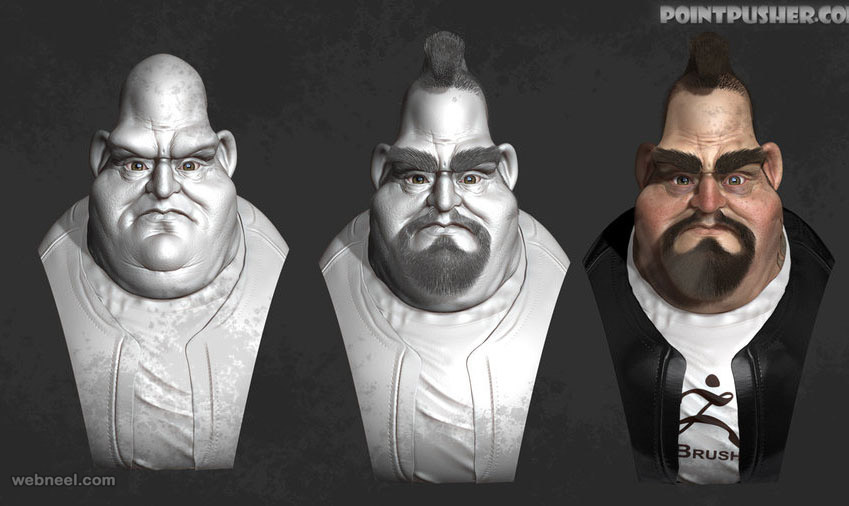

One of the other nice features to play with was the Sketch Designer (see Figure 5). But even if it is a bit buggy it is still cool, and definitely worth checking out. With a little more tweaking and some more robust features and export capabilities, I could see the walk designer even being its own stand-alone product. Overall, I found the walk designer to be a cool little feature, but not yet worthy for use in a serious production environment. BVH files in MAX, so I assume the format Poser uses is a bit off somehow. I have not had any problems loading other. Unfortunately, I encountered an error and the. However, I tried loading one of the exported walk-.BVH files onto a biped in 3D Studio MAX. Poser allows you to import and export animation as. But upon closer inspection I found some popping in the joints and some of the sliders produced some pretty weird looking movements. Initially, I was impressed and some of the results I got were very cool. By adjusting the sliders you modify the walking style in real-time. Basically, it's a bunch of sliders that let you develop various walks and runs. They call it the "Walk Designer" (see Figure 4). While we are talking about animation, now is a good time to mention the one feature I was initially really excited about.

The models come with 17 pre-set phonemes and creating my own wasn't terribly difficult. You can even sync sound files to your animated facial expressions. You can animate eyes, brows, lids, teeth, and tongue.
POSER ANIMATION FULL
Īll the new models ship with full facial controls. The animation tools are fairly easy to learn and all the animated objects have graphs associate with them (see Figure 3).įigure 3: The use of graphs makes it easy to fine-tune your animation. You can animate hands and faces, lights, cameras, props, figures, and morph shapes. OBJ figure models, and there are controls to create your own body part groups and custom blend zones and parameters. Poser also comes with templates to help you create your own textures. The company added support for transparency and reflectivity. There is even a futuristic robot collection.Īll models are fully textured. I played around with the cat and dog models for a while and found them nicely set up and very poseable. There are new left and right hand models, as well as various detailed and articulated animal models. The new people models are fully morph targeted for infinite character creation. Metacreations added new hair and over 40 articles of swappable clothing. Poser 4.0 ships with over 70 fully textured hi-resolution 3D figure models, and each figure is fully set up with IK. There is now support for individual lights' shadows being on or off, and you can animate light positions, brightness, color, and point at control. Īs far as lighting goes, in Poser 4.0 you now can have unlimited light sources and you can use either global or spot lights. The new pose dots makes working with many saved poses a snap. Having to use the sliders tends to be slower and takes away from the creative flow a bit.įigure 2. Just to clarify, the sliders do act as x y and z - they call it twist, front-back, and bend - but I would have liked better functionality of the rotate tool itself. Again, key controls or the use of the second mouse button for this task would have been nice. This distortion forced an extra undo and caused me to use two rotates instead of one. Sometimes the character would distort if I tried large rotations. I wanted the ability to lock an axis off or rotate on just one axis. The other minor glitch I came across was in the tools for posing the character. The interface is so flexible that even the background image can be moved around on the screen. Upon first glance, I didn't see that feature here.įigure 1. Also, most 3D packages have a nice standard feature that enables you to rotate the view while a key is pressed (such as ctrl or alt) and then quickly be back in whatever mode you were in before. The rotation of the camera or view seemed based upon a world axis.

I wanted a localized rotate based off the selected object or part. The tools are there, but I found their functionality to be a bit awkward. One problem was with the controls for moving the view around. I had only a few minor issues with the interface.
POSER ANIMATION WINDOWS
Also, all the windows and toolbars are hot keyed to speed up the workflow quite a bit. One simple click brings up a saved pose (see Figure 2). One new feature they added was the use of "memory dots" for saving layouts and poses.
The rollover text makes learning what each button does much quicker, and the pop out libraries work very well. It uses a large workspace and all the menus are fully moveable and collapsible (see Figure 1). The development team at Metacreations did a nice job on Poser's interface.


 0 kommentar(er)
0 kommentar(er)
